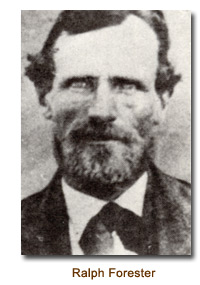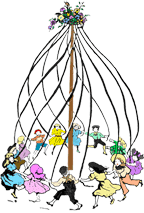- History of Ralph Forster
- Historical Sketch of Ralph Forster
History of Ralph Forster
Ralph Forster, the son of Matthew and Ann Leishman, was born in the Parish of Uphall near Edinburgh, Scotland, on October 4th, 1822 and when a lad his parents put him to work as a apprentice in one of the large bakeries of Edinburgh. Later he went to Glasgow and here he met Margaret McCollough whom he married on October 2nd, 1846. They later moved to Wingate Grange, England, it was here that they first heard the Mormon Elders. As he and his companions was returning home from work they heard that the Elder was going to hold a street meeting that evening not very far from their home. It being a strange religion they decided to go and hear what they had to say, never thinking they would be converted to their faith.
But there was something in the message those humble missionaries sank deep into their heads and after joining the church the spirit of gathering to Zion was so strong that on March 12th, 1854, they set sail for Zion, bringing his wife and son Robert, on the ship called John M. Wood, they had a very stormy voyage and was twelve weeks on the sea. I have often heard my father say he was one of the favored few, as he did not help feed the fish but he came in very handy to help wait on the sick, my mother was sick all the way across the ocean. When they arrived in New Orleans and the company was made ready to start they gave him two yoke of oxen to drive across the plains. He said he did not know any more about the oxen then they knew about him.
In making up the company they put two families to a wagon, the woman that was in the wagon with my mother was sick, so she [Margaret] told her if she would tend her baby [Robert], a year old, she would do the walking which she did. After arriving in Salt Lake City he and his friend, William Findley went to work in Big Cottonwood Canyon for a man by the name of Faramay Little, he owned a sawmill up there. This was also a new experience for them. My parents was at the big celebration in Big Cottonwood Canyon when word came that Johnson’s Army was coming and also moved with the Saints, south. In the year 1859 they [Ralph Forster & William Findley] moved to Cache Valley, which at that time, Mendon, was just a fort, all the families settled close together on account of the Indians. At this time they organized what was called the minute-men, which stood guard to protect the people from the Indians as they was quite hostile when the people first settled here. While the people still lived in the fort the [Connor] army camped over night on their way to Battle Creek, to subdue the Indians. The soldiers camped in the log schoolhouse and the people furnished them feed for their horses. This was in the winter when it was very cold.
In 1864 the people moved from the fort and settled on their city lots. While living in the fort the old log school house was built, they had a stage in one end so they could put on plays to amuse the people and my father belonged to the first dramatic company in Mendon, when they used wagon covers and quilts for scenery. When the Sunday school was organized in Mendon in 1863 he was the second superintendent and he was the one that started the May Day celebration for the Sunday school and it has been carried on ever since. When the railroad came into Mendon in 1872 he with others took stocks and worked on it to get it into the valley and when the Deseret Telegraph came into the valley they called on some of the men to furnish the poles so my father and Alfonz Willie went up into the Deep Canyon and got their two poles.
In 1863 he and several other men from Mendon [went] to the Missouri River to help bring in the emigrants, and the next year he sent his team and wagon. In 1874 Bishop Hughes was called on a mission to Wales and my father was called as bishop and it was during this time that the United Order was established and it worked harmoniously in our town until the presiding officer seen fit to make a change. When the tabernacle was built in Logan three men came over from Logan to the Mendon quarry to trim and fit the white rock that was used and my father had to see that the rock was loaded on the cars and shipped to Logan. In the year 1874 they had a very hard winter and the people ran out of food so they had to take their cattle out on the south side of the hill where the wind and sun had melted the snow and Robert said he and John Willie came home for provisions on the 21st of April and the Valley was still covered in snow.1
![]()
![]()
1. Ralph Forster History, Author Unknown, unpublished manuscript.
Historical Sketch of Ralph Forster
Ralph Forster was born near Edinburgh, Scotland, October 4th, 1822 and on March the 12th 1854 he and his wife and baby left their native land for Zion [on the] ship called John M. Wood. They encountered a very ruff sea and was twelve weeks on the ocean. In crossing the plains they encountered a great many hardships. In loading the wagons at New Orleans they had to leave a great many valuables behind. When they arrived in Salt Lake City he went to work at a sawmill in Big Cottonwood Canyon. This was a new experience for him as it was in driving those yoke of oxen across the plains. He and a man by the name of William Findley moved to Mendon in 1859 which was then a fort, here he encountered all the hardships of building up a new country. He was one of the number that helped to build what was known as the “Big Dam.” They also built their ditches to water their land and belonged to the minutemen to help guard the Indians. And when the railroad on the Promontory where the two roads met, he with his son Robert and others went out and cut wood and hauled it to the railroad so they could use it to fire the engines, as coal was scarce.
In 1863 he and several others was called to take their teams and go to the Missouri River to help bring in the emigrants. When the Deseret Telegraph line was built from Salt Lake City to Logan they called on each town to furnish the poles and my father was one of the men that went up in the canyon and helped cut the poles. When the railroad reached the Promontory in 1869 he with his son Robert and number of others went there and cut and hauled wood to fire the engines, but the wood did not prove a success and later on they got coal to fire the engines. He was the second Sunday school superintendent in Mendon and while in the Sunday school he started the May Day celebration and it has been held in Mendon ever since. In 1874 Bishop Hughes was called on a mission to [Wales], my father was called to act in his place and during this time the United Order was established and it worked harmoniously in Mendon until the presiding officer seen fit to make a change. He was at the 24th of July celebration when the word came that Johnson’s Army was coming and president Brigham Young advised the people all to move south and he and his family moved down to Lehi. Johnson’s Army came to Utah in 1857.1
![]()
![]()
1. Ralph Forster History, Author Unknown, unpublished manuscript.
